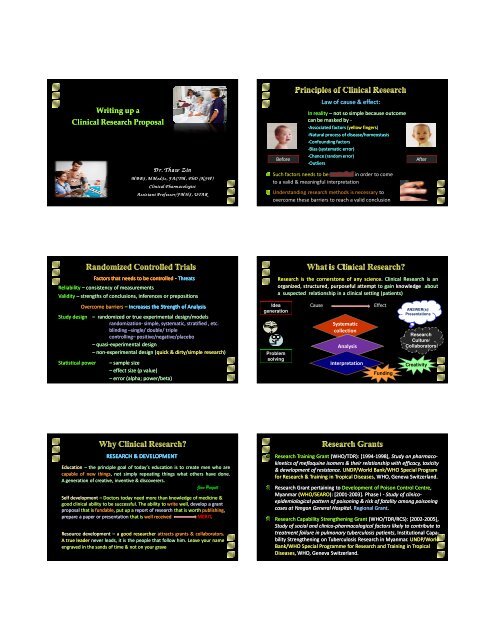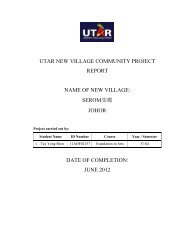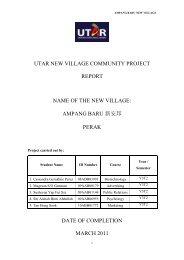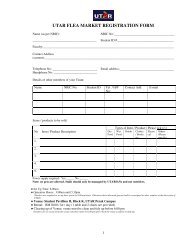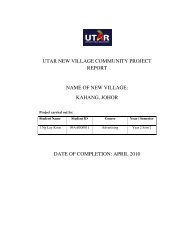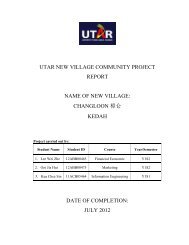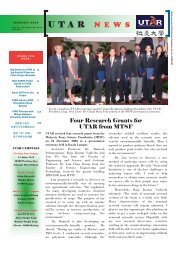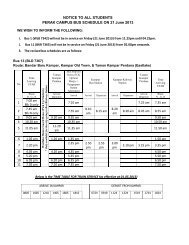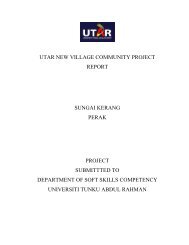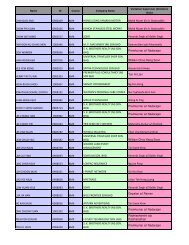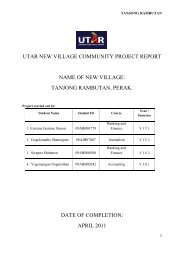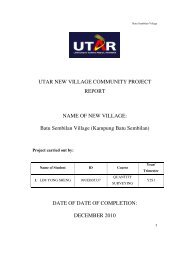Writing up a Clinical Research Proposal Dr. Thaw Dr. Thaw Zin
Writing up a Clinical Research Proposal Dr. Thaw Dr. Thaw Zin
Writing up a Clinical Research Proposal Dr. Thaw Dr. Thaw Zin
You also want an ePaper? Increase the reach of your titles
YUMPU automatically turns print PDFs into web optimized ePapers that Google loves.
<strong>Writing</strong> <strong>up</strong> a<br />
<strong>Clinical</strong> <strong>Research</strong> <strong>Proposal</strong><br />
D r. <strong>Thaw</strong> Z in<br />
M B B S, M M edSc, F A CTM , PhD (N SW )<br />
<strong>Clinical</strong> Pharm acologist<br />
A ssistant Professor/F M H S, U TA R<br />
Before<br />
Law of cause & effect:<br />
In reality – not so simple because outcome<br />
can be masked by -<br />
-Associated<br />
factors (yellow<br />
fingers)<br />
-Natural<br />
process of disease/homeostasis<br />
-Confounding<br />
factors<br />
-Bias<br />
(systematic error)<br />
-Chance<br />
(random error)<br />
-Outliers<br />
Such factors needs to be controlled in order to come<br />
to a valid & meaningful interpretation<br />
Understanding research methods is necessary to<br />
overcome these barriers to reach a valid conclusion<br />
After<br />
Factors that needs to be controlled - Threats<br />
Reliability – consistency of measurements<br />
Validity – strengths of conclusions, inferences or prepositions<br />
Study design<br />
Statistical power<br />
Overcome barriers – Increases the Strength of Analysis<br />
– randomized or true experimental design/models<br />
randomization- simple, systematic, stratified , etc.<br />
blinding –single/<br />
double/ triple<br />
controlling– positive/negative/placebo<br />
– quasi-experimental<br />
design<br />
– non-experimental<br />
design (quick<br />
& dirty/simple research)<br />
– sample size<br />
– effect size (p value)<br />
– error (alpha; power/beta)<br />
Idea<br />
generation<br />
Problem<br />
solving<br />
<strong>Research</strong> is the cornerstone of any science. <strong>Clinical</strong> <strong>Research</strong> is an<br />
organized, structured, purposeful attempt to gain knowledge about<br />
a suspected relationship in a clinical setting (patients)<br />
Cause<br />
Systematic<br />
collection<br />
Analysis<br />
Interpretation<br />
Effect<br />
Funding<br />
ANSWER(s)/<br />
Presentations<br />
<strong>Research</strong><br />
Culture/<br />
Collaborators<br />
Creativity<br />
RESEARCH & DEVELOPMENT<br />
Education – the principle goal of today’s education is to create men who are<br />
capable of new things, not simply repeating things what others have done.<br />
A generation of creative, inventive & discoverers.<br />
Jean Piagett<br />
Self development – Doctors today need more than knowledge of medicine &<br />
good clinical ability to be successful. The ability to write well, develop a grant<br />
proposal that is fundable, put <strong>up</strong> a report of research that is worth publishing,<br />
prepare a paper or presentation that is well received<br />
MERIT.<br />
Resource development – a good researcher attracts grants & collaborators.<br />
A true leader never leads, it is the people that follow him. Leave your name<br />
engraved in the sands of time & not on your grave<br />
<strong>Research</strong> Training Grant (WHO/TDR): [1994-1998], 1998], Study on pharmaco-<br />
kinetics of mefloquine isomers & their relationship with efficacy, toxicity<br />
& development of resistance. UNDP/World Bank/WHO Special Program<br />
for <strong>Research</strong> & Training in Tropical Diseases, WHO, Geneva Switzerland.<br />
<strong>Research</strong> Grant pertaining to Development of Poison Control Centre,<br />
Myanmar (WHO/SEARO): [2001-2003]. 2003]. Phase I - Study of clinico-<br />
epidemiological pattern of poisoning & risk of fatality among poisoning<br />
cases at Yangon General Hospital. Regional Grant.<br />
<strong>Research</strong> Capability Strengthening Grant (WHO/TDR/RCS): [2002-2005], 2005],<br />
Study of social and clinico-pharmacological factors likely to contribute to<br />
treatment failure in pulmonary tuberculosis patients, , Institutional Capa-<br />
bility Strengthening on Tuberculosis <strong>Research</strong> in Myanmar. UNDP/World<br />
Bank/WHO Special Programme for <strong>Research</strong> and Training in Tropical<br />
Diseases, WHO, Geneva Switzerland.
X 1,000 U$<br />
45<br />
40<br />
35<br />
30<br />
25<br />
20<br />
15<br />
10<br />
5<br />
0<br />
35<br />
30<br />
25<br />
20<br />
15<br />
10<br />
5<br />
0<br />
NPCC<br />
PARA<br />
INFO<br />
NUTR<br />
EPI<br />
NUMED<br />
VIRUS<br />
EXMED<br />
BACT<br />
ENTO<br />
2004-20052005<br />
2003-20042004<br />
IMMUN<br />
HSR<br />
EPI<br />
CRD<br />
PATHO<br />
PHARM<br />
BOD<br />
PHYSIO<br />
NUMED<br />
EXMED<br />
NBRC<br />
NUTR<br />
ENTO<br />
NPCC<br />
BACT<br />
VIRO<br />
IMMU<br />
INFO<br />
STAT<br />
HSR<br />
BIOCHEM<br />
CRD<br />
MK-Review of WHO RB (DMR-LM) - Oct 2004<br />
Southeast Asian National <strong>Research</strong> Program (SEANREP) Grant [2004-<br />
2006], Study on Traditional Medicine Culture & Impact <strong>up</strong>on Institutional<br />
Health Care in Myanmar, Toyota Foundation, Tokyo, Japan<br />
Programme/Institutional Grant (WHO/APW/NCD): [2006-2007], 2007], Cost-<br />
effectiveness of treatment approaches used for cervical & uterine<br />
cancers at Central Women Hospital & Oncology Ward, YGH. WHO SEARO<br />
Small <strong>Research</strong> Grants for Patient Safety [2009-2010], 2010], Detection of<br />
counterfeit & substandard drugs using simple techniques. World Alliance<br />
for Patient Safety, WHO/HQ, Geneva, Switzerland<br />
Regional Grant: [2009-2011]. 2011]. Assessing effectiveness of Sapium insigne<br />
in detoxification of opiate addicts by integrated Traditional Medicine<br />
Approach, WHO/SEARO<br />
Problem<br />
Solution<br />
I keep six honest serving-men,<br />
(They TAUGHT me ALL I know);<br />
Their names are WHAT & WHY & WHEN,<br />
And HOW & WHERE & WHO.<br />
Rudyard Kipling<br />
What – research target/topic<br />
Why – research rationale/objectives<br />
When – research planning/activity<br />
How – research design & approach<br />
Where – research area & implementation<br />
Who – research outcome & utilization<br />
ACTION/<br />
APPLICATION<br />
Idea<br />
Generation<br />
TITLE<br />
Of all my verse, like not a line;<br />
But like my title, for its not mine;<br />
That title from a better man I stole;<br />
Ah, how much better, had I stol’n the whole<br />
FIND FOCUS DEVELOP<br />
An ordinary person see things as they are and ask - WHY<br />
R o bert L o u is S tevenson<br />
A genius dream things as they never were and ask - WHY NOT<br />
G eorge B ernard Shaw<br />
If something is not part of a solution, then it is part of a problem<br />
Which is the best to your knowledge-<br />
- There is yet, NO solution or answer (what is = what should be)<br />
- There are MANY likely conflicting answers<br />
- Cannot be worked out by common sense<br />
ACT<br />
- Ignoring it is NOT the best answer<br />
Describe a phenomenon to others to convince them to do something<br />
Develop a method or a tool that can help solve the problem<br />
Develop a policy or guideline to solve future problems<br />
Discover/learn something new – aimed at advancement of knowledge
Disease-related factors<br />
Inappropriate<br />
patient selection<br />
Late diagnosis &<br />
treatment<br />
Poor in vitro<br />
mapping<br />
Poor drug<br />
storage<br />
facilities<br />
High parasite<br />
density<br />
Wrong selection<br />
of drugs<br />
Use of expired<br />
drugs<br />
Decrease<br />
parasite<br />
sensitivity<br />
Genetic<br />
disorders<br />
Increase in Malaria<br />
Treatment Failure<br />
Cases at the DSGH<br />
Poor quality of<br />
drugs<br />
Counterfeit &<br />
substandard drugs<br />
<strong>Dr</strong>ug-related factors<br />
Non/low<br />
immunity<br />
Inappropriate<br />
drug<br />
combination<br />
Patient related factors<br />
Area of malaria<br />
contact<br />
Poor patient<br />
compliance<br />
Inavailability of<br />
alternative<br />
treatment<br />
Associated<br />
factors<br />
age/pregnancy<br />
Poor<br />
understanding of<br />
treatment<br />
Poor knowledge of<br />
disease<br />
Previous<br />
treatment<br />
received<br />
1. Title<br />
2. Investigator(s)<br />
3. Introduction / Rationale / Justification<br />
4. Objectives<br />
5. Materials and methods<br />
6. Data collection and analysis<br />
7. Requirement<br />
8. Time Frame<br />
9. Budget estimate and its breakdown<br />
10. References<br />
Title<br />
Brief, descriptive, specific, proper syntax order<br />
Investigator(s)<br />
Relevant qualifications – degree, participatory, responsibility,<br />
background experience<br />
Resistance<br />
– Gene mutation(s) or amplification that<br />
modify drug-target (enzymes) or drug-<br />
transporter functions or affinities<br />
Introduction / Rationale / Justification<br />
Historical background – think globally, act locally<br />
Existing knowledge – what is known<br />
Gaps in knowledge – what is required<br />
Scientific merit – what is expected of the study<br />
Potential impact & utilization – target beneficiaries & end-users<br />
Treatment failure<br />
Immunity<br />
– Young children<br />
– Pregnant women<br />
– Migrants, expatriates<br />
<strong>Dr</strong>ug: Pharmacology<br />
– pharmacokinetics<br />
– pharmacodynamics<br />
– Pharmaceutics<br />
Pharmacological<br />
Factors affecting<br />
<strong>Dr</strong>ug Resistance<br />
Principal Investigator<br />
Prof Col Marlar Than, Consultant Physician/Project Manager, DSGH<br />
Co-investigators<br />
<strong>Dr</strong>. <strong>Thaw</strong> <strong>Zin</strong>, Director (<strong>Research</strong>)/<strong>Clinical</strong> Pharmacologist, DMR.<br />
<strong>Dr</strong>. Saw Lwin, Director, Vector-borne Disease Control, DOH<br />
<strong>Dr</strong> Myat Phone Kyaw, Dy Director/Medical Parasitologist, DMR<br />
<strong>Dr</strong>. Leonard Ortega, Project Advisor, WHO Regional Office, Myanmar<br />
Capt. Aung Zaw Oo, Medical Officer, 5 th Medical Battalion, Karen State<br />
<strong>Dr</strong>. Aye Yu Soe, Medical Officer, <strong>Clinical</strong> <strong>Research</strong> Unit (Malaria), DSGH<br />
Ms. Moe Moe Aye, <strong>Research</strong> Officer/Chemical Analyst, NPCC, DMR<br />
<strong>Dr</strong>. Khin Chit, Deputy Director/Project Organizer, NPCC, DMR<br />
Spread of Artemisinin Resistance in SE Asia Region
Which area of study should be given priority<br />
What is meant to be achieved at the end of the study<br />
S - Specific<br />
Criteria – be ‘SMART’<br />
M – Measurable<br />
A – Achievable<br />
R – Relevant<br />
T – Time-bound<br />
Urgency<br />
Feasibility<br />
Cost<br />
Political/ethical<br />
acceptability<br />
D<strong>up</strong>lication<br />
General Objective<br />
To assess therapeutic efficacy of first & second line drugs for the<br />
treatment of uncomplicated P. falciparum malaria<br />
Specific Objectives<br />
To measure clinical & parasitological efficacy by assessing patients with<br />
Early Treatment Failure (ETF), Late <strong>Clinical</strong> Failure (LCF), Late<br />
Parasitological Failure (LPF), or with an Adequate <strong>Clinical</strong> &<br />
Parasitological Response (ACPR) as indicators of efficacy;<br />
To differentiate recrudescence from new infections by Polymerase<br />
Chain Reaction (PCR) analysis;<br />
To evaluate the incidence of adverse events;<br />
To formulate recommendations & to enable Ministry of Health to make<br />
informed decisions about possible need for <strong>up</strong>dating of Current<br />
National Antimalarial Treatment Guidelines.<br />
Man power<br />
S<strong>up</strong>ervisor(s), PGstudents, collaborators, hospital staff, laboratory<br />
staff, technical assistants, field workers, etc.<br />
Money/ Funds<br />
WHO/UNDP/World Bank/UNICEF/JICA/Foundations/IAEA/KOICA/<br />
DMR grant/Wellcome Trust/Industry or out from your own pocket<br />
Materials<br />
Subjects, samples, laboratory facilities - availability, accessibility,<br />
timing, procedures & permission, storage, transport, computer<br />
facilities, etc.<br />
Methods<br />
Development, standardization, validation (reliability criteria)<br />
Time frame – need to finish, extendibility, interim analysis<br />
<strong>Research</strong><br />
Conflicts<br />
Administrator<br />
TLC<br />
<strong>Research</strong> Models:<br />
Intervention<br />
- Deficit<br />
- Distrust<br />
- Conflict<br />
- Conformity<br />
<strong>Research</strong>er<br />
Cause<br />
Valid data<br />
Physician<br />
Patient Outcome care<br />
Developing a<br />
<strong>Research</strong> Team<br />
F = Flexible/Fair<br />
R = Responsible<br />
E = Energetic<br />
A = Available<br />
K = Knowledgeable<br />
T = Together<br />
E = Everybody<br />
A = Achieves<br />
M = More<br />
“I learn from my patients and my dear colleagues,<br />
what I can never learn from books or my teachers”<br />
Henry Brook Adams<br />
Correction & Critics:<br />
If well received,<br />
Will save our future,<br />
A lot of grief.<br />
For, as the twig is BENT;<br />
So grows the tree.<br />
E u gene P atterson<br />
Once done; cannot repeat on patients
• Inj artemether:<br />
Quality is NEVER an accident<br />
It is ALWAYS the result of<br />
*High intension, *sincere effort,<br />
*Intelligent direction, & *skillful execution<br />
Standards<br />
Principal investigator<br />
S<strong>up</strong>ervisor/facilitator<br />
Prestige<br />
Collaborators<br />
Technical staff<br />
• Inj artesunate:<br />
• Inj quinine:<br />
• Tab artemether:<br />
• Tab artesunate:<br />
• Mefloquine:<br />
• Quinine:<br />
• Chloroquine:<br />
• Primaquine<br />
• Doxycycline:<br />
Trial strategy<br />
One arm, comparative study, using parallel gro<strong>up</strong> design<br />
Non-inferiority trial if comparison of 2 highly effective medicines<br />
S<strong>up</strong>eriority if comparison of highly effective vs failing medicine<br />
Study site<br />
Defence Services General Hospital (DSGH)<br />
Fifth Medical Battalion, Mawlamyaing (primary drainage site)<br />
Sentinel site network around FMB (secondary drainage site)<br />
Study population<br />
Patients all age gro<strong>up</strong> diagnosed with uncomplicated P. falciparum<br />
malaria & having given or whose parents or guardians have given<br />
an informed consent for study inclusion and assent in children as<br />
appropriate.<br />
Inclusion criteria<br />
All patients over 6 months with mono-infection with P. falciparum<br />
Detected at microscopy, parasite count between 1000–100<br />
000/μl<br />
Axillary T°≥ 37.5°C or history of high fever during last 24 hours<br />
Ability to swallow oral medication; without h/o allergic to medicine<br />
Ability & willingness to comply with the study protocol<br />
Agreed written informed consent from patient/parent/guardian, in<br />
case of children.<br />
Exclusion criteria<br />
General danger signs of severe & complicated falciparum malaria<br />
Mixed infection with another Plasmodium species<br />
Taken any antimalaria drug within the last week<br />
Any associated diseases which can act as confounding factors<br />
Women with positive pregnancy test or who are breastfeeding<br />
Anticipated population proportion (P), confidence level 95%<br />
d 0.05 0.10 0.15 0.20 0.25 0.30 0.35 0.40 0.45 0.50<br />
0.05 73 138 196 246 288 323 350 369 380 384<br />
0.10 18 a 35 a 49 a 61 72 81 87 92 95 96<br />
a<br />
In order to be representative, a minimum of 50 patients should<br />
always be included.
Antimalaria drug administration<br />
First & second line drugs, regime according national guidelines<br />
Preferably fasting/light diet; drug administered with 200 mL water<br />
Clearance required from National/DMR Committee on Medical Ethics for<br />
studies involving human subjects<br />
Timing & duration of study<br />
During malaria transmission (rainy) season; May to November<br />
2008/2009<br />
Timed-blood samples collected at specified intervals as scheduled<br />
Follow-<strong>up</strong> of 28 days minimum<br />
Tools for data validation/correction<br />
Genotyping to distinguish between recrudescence & re-infection<br />
In vitro sensitivity test & molecular markers for drug resistance,<br />
Pharmacokinetic study for bioavailability & dosages assessment<br />
Pharmaceutical analysis for quality assurance of drugs used<br />
Early Treatment Failure (ETF)<br />
– Development of danger signs or severe malaria on D1, D2, D3 in presence of parasitemia<br />
– Parasitemia on D2 higher than D0<br />
– Parasitemia on D3 > 25% count D0<br />
– Parasitemia on D3 with axillary temperature > 37.5°C<br />
Late <strong>Clinical</strong> Failure (LCF)<br />
– Development of danger signs/severe malaria after Day 3 in the presence of parasitaemia<br />
without previously meeting any of criteria of early treatment failure;<br />
– Presence of parasitaemia & axillary temperature > 37.5°C on any day from Day 4 to Day<br />
28, without previously meeting any of criteria of early treatment failure<br />
Late Parasitological Failure (LPF)<br />
– Presence of parasitaemia on any day from Day 7 to Day 28, axillary temperature < 37.5°C,<br />
without previously meeting any of criteria of early treatment failure or late clinical failure<br />
Adequlate <strong>Clinical</strong> & Parasitological Response (ACPR)<br />
– Absence of parasitemia on Day 28 irrespective of axillary temperature without previously<br />
meeting any of criteria of early treatment failure or late clinical or parasitological failure<br />
Procedures<br />
<strong>Clinical</strong><br />
Assessment<br />
Day 0 Day 1 Day 2 Day 3 Day 7 Day 14 Day 21 Day 28 Any other<br />
day<br />
X X X X X X X X X<br />
Temperature X X X X X X X X X<br />
Blood slide for<br />
Parasite count<br />
X (X) X X X X X X (X)<br />
Hb & Hct (X) (X) (X) (X)<br />
Urine sample<br />
(X)<br />
Blood for PCR X X X X X X (after<br />
Day 7)<br />
Treatment<br />
<strong>Dr</strong>ug to be tested X X (X)<br />
Rescue treatment (X) (X) (X) (X) (X) (X) (X) (X)<br />
Molecular markers of drug resistance<br />
• Compulsory for TET (longer follow-<strong>up</strong>)<br />
• Sampling D0, D7, D14, D21, D failure,<br />
D28<br />
• Genotyping only D0 and D failure<br />
• Consensus on standardization during<br />
co-sponsored WHO MMV meeting<br />
– Sampling scheme<br />
– Methods of blood sampling and sample<br />
storage<br />
– Genotyping strategy<br />
– Analyses and outcome classification<br />
– Quality control<br />
– Genotyping of P. vivax<br />
Compound class <strong>Dr</strong>ugs Gene Codon with<br />
AA change<br />
4-aminoquinolines Chloroquine pfcrt 76<br />
pfmdr 186 (1034, 1042, 1246)<br />
Antifolate Pyrimethamine dhfr 108, 51, 59, 164<br />
Sulfadoxine dhps 436, 437, 540, 581, 613<br />
Amino-alcohols Mefloquine pfmdr1 copy number<br />
Sesquiterpene lactone Artemisinin pfmdr1 copy number <br />
derivatives pfATPase6 <br />
Naphtoquinine Atovaquone cyt b
Pharmacokinetic Analysis<br />
<strong>Dr</strong>ug-plasma concentrations of artesunate and DHA will be<br />
performed using a LCMS & HPLC-UV<br />
methods respectively.<br />
Pharmacokinetic data - analyzed using WinNonlin Professional<br />
(Pharsight Corporation, Mountain View, CA).<br />
Population Pharmacokinetic/dynamid method applied using<br />
nonlinear mixed-effects effects models<br />
Pharmacokinetic/dynamic linkage will be explored using logistic<br />
regression analysis of treatment success or failure<br />
Statistical Analysis<br />
All statistical analyses will be performed using SPSS (IBM ver. 4.1)<br />
Time to parasite & fever clearance will be estimated using Kaplan-<br />
Meier survival analysis, & linear log regression of serial log-parasite<br />
counts in each patient.<br />
First Year<br />
Second Year<br />
Project activities<br />
Planning phase<br />
-Consultant<br />
-Training<br />
-Data<br />
collection<br />
1 st<br />
Quarter<br />
2 nd<br />
Quarter<br />
3 rd<br />
Quarter<br />
4 th<br />
Quarter<br />
1 st<br />
Quarter<br />
2 nd<br />
Quarter<br />
3 rd<br />
Quarter<br />
4 th<br />
Quarter<br />
Implementation<br />
-Trials/Experiments<br />
-Surveys/Treatments<br />
-Intervention<br />
/<br />
Monitoring<br />
-Post-intervention<br />
Data Analysis<br />
Report <strong>Writing</strong><br />
BUDGET<br />
Personnel<br />
Labour cost<br />
Patient care<br />
Travel<br />
Equipments & s<strong>up</strong>plies<br />
Sample storage & transfer<br />
Chemicals/Medicines<br />
Trainings/workshop<br />
Consultants<br />
Data processing<br />
First Year<br />
(US$)<br />
1200.00<br />
1400.00<br />
800.00<br />
700.00<br />
7500.00<br />
700.00<br />
1200.00<br />
400.00<br />
-<br />
Second Year<br />
(US$)<br />
800.00<br />
800.00<br />
800.00<br />
1000.00<br />
1500.00<br />
200.00<br />
-<br />
1000.00<br />
-<br />
Total<br />
(US$)<br />
2000.00<br />
2200.00<br />
1600.00<br />
1700.00<br />
9000.00<br />
900.00<br />
1200.00<br />
400.00<br />
TOTAL 13,900.00 6,100.00 20,000.00<br />
REFERENCES<br />
When will<br />
research END<br />
Implement<br />
Set Action<br />
Plan<br />
Identify<br />
Cause<br />
Problems<br />
Problems<br />
Identify<br />
Cause<br />
Implement<br />
Set Action<br />
Plan<br />
<strong>Research</strong>, Development and Problem Solving Cycle
100.0<br />
%T<br />
50.0<br />
0.0<br />
Std A-001<br />
A-01<br />
A-012<br />
A-013<br />
A-018<br />
A-020<br />
A-024<br />
-50.0<br />
4000.0<br />
3000.0<br />
2000.0<br />
1500.0<br />
1000.0<br />
500.0<br />
ARTE13<br />
1/cm<br />
S<strong>up</strong>erimposition of FT-IR Spectrum of ArtesunateTablets<br />
Knowledge gives individuals &<br />
organizations the capacity to<br />
‘ACT’<br />
1. Reality to Data<br />
2. Data to Information<br />
3. Information to Knowledge<br />
4. Knowledge to Wisdom<br />
Series of transformations<br />
Knowledge<br />
Data<br />
Closing the “Know-do” Gap<br />
Context<br />
Independence<br />
Useful Information<br />
Understanding<br />
relations<br />
Understanding<br />
principles<br />
Knowledge to ACT<br />
Understanding<br />
patterns<br />
Performance<br />
Guidelines<br />
Understanding<br />
Comparative bioequivalence between different artesunate brands<br />
available in Myanmar<br />
Sample Uniformity of<br />
weight pH value<br />
(1%) Disinte-<br />
gration<br />
timeQualitative<br />
Identific-ation<br />
ationAssay<br />
A-001<br />
2.7 -3.9 5.1 110 A-010<br />
1.2 -1.8 4.6 3 102 0.7 -1.3 4.9 4 112 A-013<br />
2.8 -2.5 5.4 5 104 A-018<br />
1.6 –3.5 6.4 60 7 A-020<br />
0.5 -0.6 4.1 2 108 A-012<br />
2.6 -5.1 6.3 26 15 Artesunate (Standard) 2.7 -3.2 % 4.0 5min + 100 % A-024<br />
Dihydroartemisinin concentration<br />
Parasite biomass<br />
Piperaquine concentration<br />
Residual parasites<br />
Predicted efficacy of DHA-PQ Incorporating of drug<br />
pharmacokinetic & dynamic clearance of parasite through<br />
the use of Mixed-effect Modeling (Kill Curve)<br />
Questions, discussions, critics, comments ….<br />
46
“H ow foolish I w ou ld be, to stare w ith aw e at th e ligh t of th e can d le,<br />
W h en I can , in fact, beh old - th e rad iance of th e su n ”<br />
Longfellow


